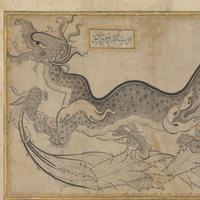More about Shahquli
Works by Shahquli

Contributor
Shah Quli was a Persian painter responsible for founding and spreading the “saz uslubu” (reed style) that permeated Ottoman murals and paintings throughout the empire during his time.
His use of dragons and other fantastical creatures amongst larger than life foliage was a byproduct of the Tabriz school of painting, characterized by the adoption of Chinese art styles into the animal and plants of Islamic art. He was a student of Āqā Mīrak, who himself had an illustrious pedigree as a direct descendant of Muhammad and whose work was characterized by vibrant, richly-detailed portraiture. From Mīrak, Quli learned how to paint, embroider, and write poetry under the alias of Alwani.
Quli was brought to Amasya following Sultan Selim’s victory at the Battle of Chaldiran in 1514. When his son Suleyman’s ascended to the throne in 1520, he became the highest paid artist in the realm and was head of the royal atelier in Istanbul for forty-two years, applying what he learned in Tabriz toward Ottoman murals, paintings, and drawings. Some of Quli’s repertoire under the Magnificent’s reign include the wall panels of the Circumcision Room in the Topkapi Palace, designs for carpets used in court, and the illumination of a copy of "Joseph and Zuleika" by the fifthteenth-century poet Jami.
The Ottoman Empire under Suleyman saw itself expand into its greatest reach, going as far west as to border Austria and as far east as Iraq. With greater reach came greater economic growth and globalization, leading to a boom in cultural, societal and artistic developments that cemented the reign of Suleyman as a golden age and gave him the titles “Magnificent” and “Lawgiver.” With Suleyman’s influence, Quli became one the Ottoman Empire’s most prolific artists. Even with him long gone, the “saz uslubu” can be seen in mosques, schools, the tiles of the Dome of the Rock, and in the later additions to the holy sites of Mecca and Medina.
Sources
- Akin-Kivanc, Esra. (2015). Mustafa li’s Epic Deeds of Artists and New Approaches to Written Sources of Ottoman Art. Journal of the Ottoman and Turkish Studies Association. 2. 10.2979/jottturstuass.2.2.02., 268.
- Britannica, The Editors of Encyclopaedia. 1998. “Tabrīz School.” Encyclopædia Britannica. Encyclopædia Britannica, inc. July 20, 1998. https://www.britannica.com/art/Tabriz-school.
- Britannica, The Editors of Encyclopaedia. 1998. “Āqā Mīrak.” Encyclopædia Britannica. Encyclopædia Britannica, inc. July 20, 1998. https://www.britannica.com/biography/Aqa-Mirak.
- Flood, Finbarr Barry., and Necipoğlu Gülru. 2017. A Companion to Islamic Art and Architecture. Oxford: Wiley Blackwell.
- Karmaroff, Linda. 1992. “The Age of Süleyman ‘the Magnificent’ (r. 1520–1566).” Edited by Suzan Yalman. Metmuseum.org. The Metropolitan Museum of Art. October 1992. https://www.metmuseum.org/toah/hd/suly/hd_suly.htm.
- Mahir, Banu. "Saray Nakkaşhanesinin Ünlü Ressamı Şah Kulu ve Eserleri”, Topkapı Sarayı Müzesi Yıllık 1, (Istanbul 1986), p.113-130.
Featured Content
Here is what Wikipedia says about Şahkulu (painter)

Şahkulu (Ottoman Turkish: شاه قولی; Persian: شاهقلی بغدادی Shāhqulī-i Baghdādī; died 1556) was an Ottoman painter who played a leading role in a formation of the saz style.
Saz style "in which mythical creatures derived from Chinese or Islamic sources move through an enchanted forest made up of oversized composite blossoms and feathery leaves, has parallels in the art of the Aqqoyunlu and Safavid courts at Tabriz, where Shahquli trained under a master named Aqa Mirak" (it was not the well-known painter of Tahmasp's court). According to Sam Mirza Safavi (who does not mention his emigration to Ottoman lands) Şahkulu came from Qom. His name is in a document found in Ottoman Archives among the scholars and artisans who were exiled from Tabriz to Istanbul via Amasya on 12 April 1515, the aftermath of Ottoman occupation of Tabriz after the battle of Chaldiran. The 1525-26 register of court artisans list him as the head draftsman (ressam) of the twenty-nine artists and twelve apprentices employed there, with high daily salary of twenty two akçe. He became popular with Suleiman, to whom he gave a picture of a peri, and received gifts including 2000 akçe and broaded caftans and velvets. Another register from the same year adds the note that he joined the Istanbul naqqash khana ("painter's house") in 1520–21.
He next appears in 1545-46 as head (sar buluk) of the Anatolian ("Rumi") section of the naqqash khana (it was one of the two sections). According to Mustafa Ali, writing in 1586, Şahkulu was given an independent studio where the sultan liked to watch him work, together with a position of chief painter (naqqash bashi) and salary of one hundred akçe (this last figure is probably an exaggeration, because the salary would have been without precedent). A note in a list of gifts made by the sultan to his court artists in 1555–6 states that Şahkulu had died before the gift could be presented to him. His most important pupil was Kara Memi.
The role of Şahkulu in formation of saz style "is of great importance, even though it is difficult to attribute firmly to his hand more than a small number of works". Şahkulu signature is found on two ink drawings: one (damaged; Topkapı Pal. Lib., H. 2154, fol. 2r) represents a dragon and was incorporated into an album, the preface of which was written in 1544–5; the other (Freer, 37.7) depicts a flying peri (angel) with a cup and wine flask. A third drawing which bears his name (Met., 57.51.26), also representing a dragon, appears to be a later copy. His "refined brushwork and strong sense of design and dramatic movement are also seen in several unsigned drawings of dragons and peris and studies of blossoms and leaves". The importance given in later times to his name in the history of Ottoman art resulted in its "being attached to a great number of works of diverse styles and periods, not unlike the numerous 'signatures' of Riza and Bihzad".
-
Angel (peri), flying, with cup and wine flask (signed). Freer Gallery of Art
-
Kneeling Angel (peri) with Cup and Bottle (attribution). Freer Gallery of Art
-
Combat between dragon and lion (attribution) Topkapı Palace Library
-
Two pages from the Sultan Murad III Album (Muraqqa) (attribution). Austrian National Library
-
Dragon (left) and hatayi blossoms (right). It is highly possible that these two drawings were executed by Şahkulu. Istanbul University Library
-
Later copy of the drawing of a dragon. Metropolitan Museum of Art
Check out the full Wikipedia article about Şahkulu (painter)











